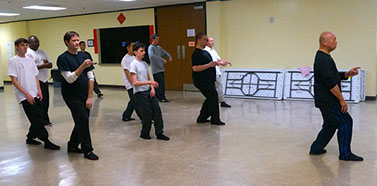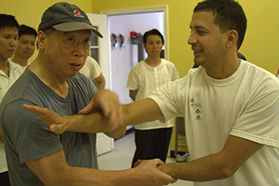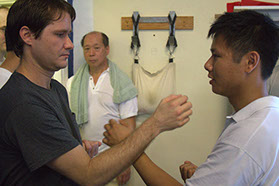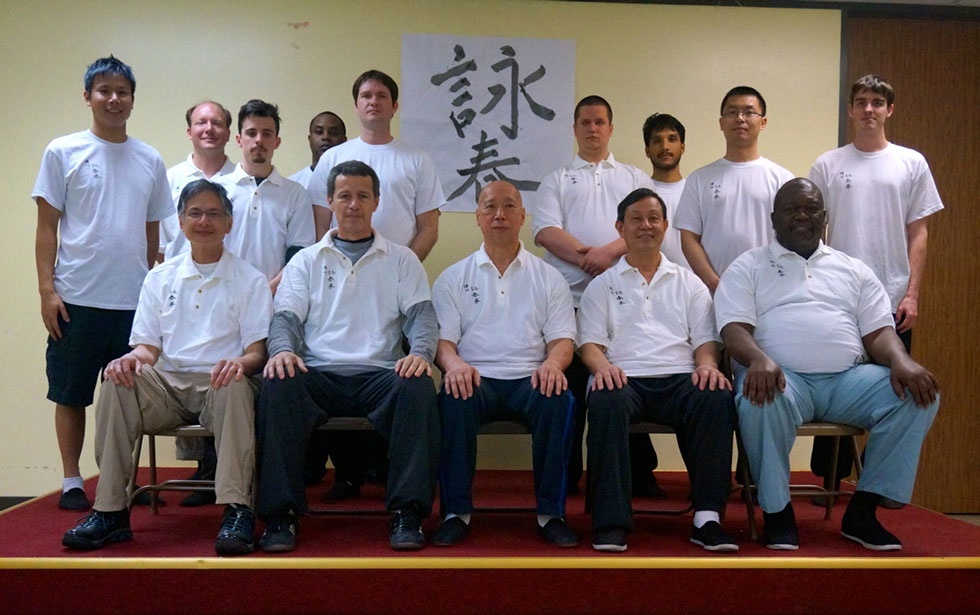HISTORY OF WING CHUN
Wing Chun was first introduced to the public in 1949 with the arrival of Grand Master Yip Man in Hong Kong. Despite a competitive landscape of many martial arts in the city of Hong Kong, the popularity of Wing Chun grew. As the city of Hong Kong goes through its own industrial revolution and its population sky rocket, people had to adopt to living and working in tight spaces. So it is no surprise that people in Hong Kong were especially fond of the effectiveness of Wing Chun, and its applicability in close quarter combat. Yip Man's two most senior students, Leung Sheung and Lok Yiu were particularly popular among blue collar workers.
WHAT IS WING CHUN
Wing Chun (詠春) is a southern Chinese martial art style. Wing Chun is characterized for the emphasis of Straight Line principle, integrating the position, sensitivity and energy. The WC system training consists of:
LEUNG SHEUNG LINEAGE OF WING CHUN
Master Leung Sheung (1918-1978) was a well known teacher of many Chinese martial arts styles in the 1940's. When the infamous Grand Master Yip (Ip) Man (1893-1972) arrived in Hong Kong in 1949 after the Chinese Civil War, Leung Sheung met with Yip Man through a mutual friend.
Upon meeting Yip Man, Leung Sheung was quickly convinced of the superiority of Wing Chun. Leung Sheung relinquished all the other styles he invested years of work in, and began studying Wing Chun as Yip Man's first student in Hong Kong.
With years of devotion and sacrifice, Leung Sheung became a widely recognized Wing Chun master and one of the most popular Wing Chun teacher in the 1960's. One of Leung Sheung's many students in the 1960's is Sifu Kenneth Chung.
Sifu Kenneth Chung began his training as a teenager in Leung Sheung's school. With devotion and hard work, Kenneth Chung quickly became one of Leung Sheung's best student. In 1968, Sifu Kenneth Chung went to California to study in college. With the intention of seeking work out partners, he met up with a few local martial arts practicioners in the area.
Impressed with Sifu Kenneth Chung's skills, they invited him to teach them Wing Chun. So Sifu Kenneth Chung started teaching Wing Chun in California. After graduation, Sifu Kenneth Chung returned to Hong Kong and continued his Wing Chun training with Master Leung Sheung. In the mid 1970's, Sifu Kenneth Chung returned to California and has been teaching Wing Chun ever since.
HOUSTON WING CHUN ASSOCIATION
The Houston Wing Chun Association was founded in 1991 to promote and teach Leung Sheung Wing Chun.
Started in 1968, Sifu Kenneth Chung (Chung Maan Nin) began teaching Leung Sheung Wing Chun in California. Sifu Kenneth Chung's legacy continues to grow through out the United States, and now there are branches in California, Washington, Florida, New York, Ohio, Texas, Shanghai and Singapore.
During a martial art tournament held in Houston, Texas on labor day weekend of 1990, Mr. Humphrey Wong (lead instructor of Houston Wing Chun Association) and a few other founding members invited Sifu Kenneth Chung to start teaching in Houston, Texas.
From there, Sifu Kenneth Chung has been hosting quarterly workshops in Houston, Texas for over 20 years.
CLASSES
Classes are Tuesdays and Thursdays from 7:30 PM TO 9:00 PM
Dress attire is white t-shirt with black kung-fu pants and kung-fu slippers
We offer the first 3 classes for potential students to try out for free. After that, class fee is $80 per month. We collect the 1st and 2nd month fees when you commit to joining the class.
Mandatory workshops are twice a year for $200 per workshop
Please print a copy of the liability waiver, sign it and bring it to class with you
LOCATION
Classes held at Houston Gymnastics Academy
(5804 South Rice Avenue, Houston, TX 77081)
We are not directly associated with the Houston Gymnastic Academy. So many of the staff there are not familiar with us.
Please come in through the front door. Take an immediate right down the narrow hallway, and go pass the door. You will see the entrance to our room on the right (It is the northwest corner of the building). There is a wooden dummy by the entrance.
INSTRUCTORS
Classes are led by John and Lau
Class members training for 5 - 10 years assist new practitioners to develop their skills
MANDATORY WORKSHOPS
Workshops usually held 2 to 3 times annually on Saturdays and Sundays from 10:30 AM - 6:30 PM
Cost is $200
Next workshop scheduled for April 1 & 2, 2017



Houston Wing Chun Association

